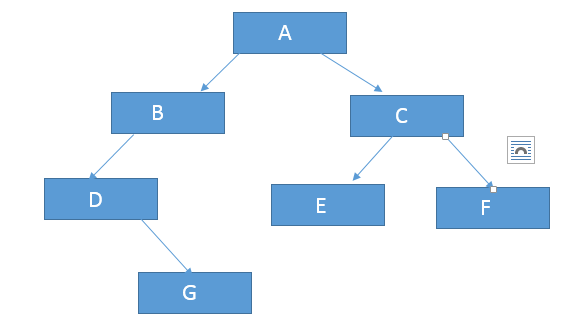1:二叉树的建立
二叉树的建立有两种模式:(1):首先设计二叉树的结点类,然后在此基础上,用static成员函数实现二叉树的具体操作。
(2):设计二叉树的结点类,然后在二叉树的结点类的基础上设计二叉树类。
1 /* 2 * 定义一个二叉树的结点类 3 */ 4 public class BinTreeNode { 5 private BinTreeNode leftChild; 6 private BinTreeNode rightChild; 7 private Object data; 8 9 public BinTreeNode(){ 10 leftChild=null; 11 rightChild=null; 12 } 13 14 public BinTreeNode(BinTreeNode left, BinTreeNode right,Object Idata){ 15 leftChild=left; 16 rightChild=right; 17 data=Idata; 18 } 19 20 public BinTreeNode getLeftChild() { 21 return leftChild; 22 } 23 24 public BinTreeNode getRightChild() { 25 return rightChild; 26 } 27 28 public Object getData() { 29 return data; 30 } 31 }
设计完了二叉树的结点类之后,在二叉树的结点类的基础上用static成员函数实现二叉树的具体操作。
包括二叉树的生成,二叉树的打印,二叉树的遍历,在二叉树中查找元素。
(1)首先在二叉树结点类的基础上构建二叉树。结构如上图所示:

先构造一个方法用于获得二叉树的结点类
//获得一个二叉树结点的类 public static BinTreeNode getTreeNode(Object item, BinTreeNode left, BinTreeNode right){ //构造一个二叉树 BinTreeNode temp=new BinTreeNode(left, right, item); return temp; }
//在结点类的基础上构造一个二叉树 public static BinTreeNode makeTree(){ BinTreeNode a,b,c,d,e,f,g,h; g=getTreeNode(new Character('G'), null, null); d=getTreeNode(new Character('D'), null, g); b=getTreeNode(new Character('B'), d, null); e=getTreeNode(new Character('E'), null, null); f=getTreeNode(new Character('F'), null, null); c=getTreeNode(new Character('C'), e, f); return getTreeNode(new Character('A'), b, c); }
(2) 打印一棵二叉树
1 //打印二叉树,主要将纵向的二叉树横过来,基本的思维是先打印右子树,根节点,左子树 2 public static void printBiTree(BinTreeNode root, int level){ 3 if (root!=null) { 4 //根节点root的level+1层开始输出右子树,不断的递归调用 5 printBiTree(root.getRightChild(), level+1); 6 7 if (level!=0) { 8 for(int i=0; i<6*(level-1); i++){ 9 System.out.print(" "); 10 } 11 System.out.print("---"); 12 } 13 System.out.println(root.getData()); //输出结点数据元素的值 14 15 //根节点root的level+1层开始输出左二叉树,不断的递归调用 16 printBiTree(root.getLeftChild(), level+1); 17 } 18 }
(3):查找二叉树中的某个元素
1 //定义一个方法在二叉树中查找某个(x)元素 2 public static BinTreeNode search(BinTreeNode t,Object x){ 3 4 BinTreeNode temp; 5 if (t==null) return null; //查询失败 6 if (t.getData().equals(x)) return t; //查找成功返回某个子二叉树 7 8 //在左子树寻找元素 9 if(t.getLeftChild()!=null){ 10 temp=search(t.getLeftChild(), x); 11 if (temp!=null) return temp; 12 } 13 //在右子树中寻找元素 14 if(t.getRightChild()!=null){ 15 temp=search(t.getRightChild(), x); 16 if (temp!=null) return temp; 17 } 18 return null; //查询失败的出口 19 }
(5):实现二叉树中最重要的遍历,用递归的方法实现。当然后面肯定有非递归的方法。
首先需要定义一个访问二叉树结点的方法
1 /* 2 * 定义一个类用于打印输出每个结点 3 */ 4 public class Visit { 5 public void print(Object item){ 6 System.out.print(item+" "); 7 } 8 }
/* * 定义一个用于遍历二叉树的类 */ public class BinTraverse { //前序遍历 public static void preOrder(BinTreeNode t, Visit v){ //如果是非递归的方法遍历二叉树,此时这里面的if 还能用if吗? if (t!=null) { v.print(t.getData()); preOrder(t.getLeftChild(), v); preOrder(t.getRightChild(), v); } } //中序遍历 public static void inOrder(BinTreeNode t, Visit v){ if (t!=null) { inOrder(t.getLeftChild(), v); v.print(t.getData()); inOrder(t.getRightChild() , v); } } //后序遍历 public static void postOrder(BinTreeNode t, Visit v){ if (t!=null) { postOrder(t.getLeftChild(), v); postOrder(t.getRightChild(), v); v.print(t.getData()); } } //层序遍历,层序遍历的基本原理是,每遍历一个根节点则进去左右两个孩子节点 //逻辑类似于队列,先进先出 public static void levelOrder(BinTreeNode t, Visit v) throws Exception{ LinQueue lq=new LinQueue(); //这里面需要链式队列的类型 if (t==null) return; BinTreeNode curr; lq.append(t); while (lq.notEmpty()) { curr=(BinTreeNode) lq.delete(); //从队列中删除根节点,并且将队列转化为二叉树的一个结点 v.print(curr.getData()); //并且输出该节点的值 //将左右结点分别插入到队列中 if (curr.getLeftChild()!=null) lq.append(curr.getLeftChild()); if (curr.getRightChild()!=null) lq.append(curr.getRightChild()); } } }
1 /* 2 * main函数 3 */ 4 public static void main(String[] args) { 5 BinTreeNode root1; 6 BinTreeNode temp2; 7 8 Visit v=new Visit(); 9 10 root1=makeTree(); 11 System.out.println("二叉树为: "); 12 printBiTree(root1, 0); 13 System.out.println(); 14 15 16 System.out.println("前序遍历节点序列为:"); 17 BinTraverse.preOrder(root1, v); 18 System.out.println(); 19 20 System.out.println("中序遍历节点序列为:"); 21 BinTraverse.inOrder(root1, v); 22 System.out.println(); 23 24 System.out.println("后序遍历节点序列为:"); 25 BinTraverse.postOrder(root1, v); 26 System.out.println(); 27 28 29 //查找某个元素 30 temp2=search(root1, new Character('F')); 31 if (temp2!=null) { 32 System.out.println("查到该节点的数据元素为: "+temp2.getData()); 33 } 34 else{ 35 System.out.println("查找失败!"); 36 }
**************上面说道二叉树的建立,有两种方法,下面实现第二种方便生成二叉树,在结点的基础之上建立二叉树的类。**********
(1)二叉树结点类
1 /* 2 * 定义一个二叉树的结点类 3 */ 4 public class BinTreeNode { 5 private BinTreeNode leftChild; 6 private BinTreeNode rightChild; 7 private Object data; 8 9 public BinTreeNode(){ 10 leftChild=null; 11 rightChild=null; 12 } 13 14 public BinTreeNode(BinTreeNode left, BinTreeNode right,Object Idata){ 15 leftChild=left; 16 rightChild=right; 17 data=Idata; 18 } 19 20 public BinTreeNode getLeftChild() { 21 return leftChild; 22 } 23 24 public BinTreeNode getRightChild() { 25 return rightChild; 26 } 27 28 public Object getData() { 29 return data; 30 } 31 }
在二叉树结点类的基础上实现二叉树
1 /* 2 * 先在二叉树结点类的基础上,设计二叉树类 3 */ 4 public class BinTree { 5 private BinTreeNode root; //根指针 6 7 8 //前序遍历 9 public void preOrder(BinTreeNode t, Visit s){ 10 if (t!=null) { 11 s.print(t.getData()); 12 preOrder(t.getLeftChild(), s); 13 preOrder(t.getRightChild(), s); 14 } 15 } 16 17 //中序遍历 18 public void inOrder(BinTreeNode t, Visit s){ 19 if (t!=null) { 20 inOrder(t.getLeftChild(), s); 21 s.print(t.getData()); 22 inOrder(t.getRightChild(), s); 23 } 24 } 25 26 //后序遍历 27 public void postOrder(BinTreeNode t, Visit s){ 28 if (t!=null) { 29 postOrder(t.getLeftChild(), s); 30 postOrder(t.getRightChild(), s); 31 s.print(t.getData()); 32 } 33 } 34 35 //构造函数用于初始化root结点 36 public BinTree(){ 37 root= null; 38 } 39 40 //构造函数用于处理一个二叉树 41 public BinTree( BinTree left, BinTree right,Object item){ 42 BinTreeNode leftNode; 43 BinTreeNode rightNode; 44 45 if (left==null) { 46 leftNode=null; 47 }else{ 48 leftNode=left.root; //让左子树获得左子树的结点 49 } 50 51 if (right==null) { 52 rightNode=null; 53 }else{ 54 rightNode=right.root; 55 } 56 57 root=new BinTreeNode(leftNode, rightNode, item); 58 59 } 60 61 //前序遍历 在二叉树类遍历的基础上,调用二叉树结点遍历方法还是让二叉树结点类实现递归作用,因为最终遍历的都是书的结点 62 public void preOrder(Visit vs){ 63 preOrder(root, vs); 64 } 65 66 //中序遍历 67 public void inOrder(Visit vs){ 68 inOrder(root, vs); 69 } 70 71 //后序遍历 72 public void postOrder(Visit vs){ 73 postOrder(root, vs); 74 } 75 }
写一个测试类,包括二叉树的建立,以及二叉树的遍历。
1 public static void main(String[] args) { 2 3 //构造第二种方法的二叉树 4 BinTree g=new BinTree(null, null, new Character('G')); 5 BinTree d=new BinTree(null, g, new Character('D')); 6 BinTree b=new BinTree(d, null, new Character('B')); 7 BinTree e=new BinTree(null, null, new Character('E')); 8 BinTree f=new BinTree(null, null, new Character('F')); 9 BinTree c=new BinTree(e, f, new Character('C')); 10 BinTree a=new BinTree(b, c, new Character('A')); 11 12 13 Visit v=new Visit(); 14 15 System.out.print("前序遍历结点序列为:"); 16 a.preOrder(v); 17 System.out.println(); 18 19 System.out.print("中序遍历结点序列为:"); 20 a.inOrder(v); 21 System.out.println(); 22 23 System.out.print("后序遍历结点序列为:"); 24 a.postOrder(v); 25 System.out.println(); 26 }
大体的实现就是这样,还是感叹一句啊,在能够完全理解的情况下还是要多敲代码啊!!!!
No more talking,show me coding!!
下一节:非递归的二叉树遍历。